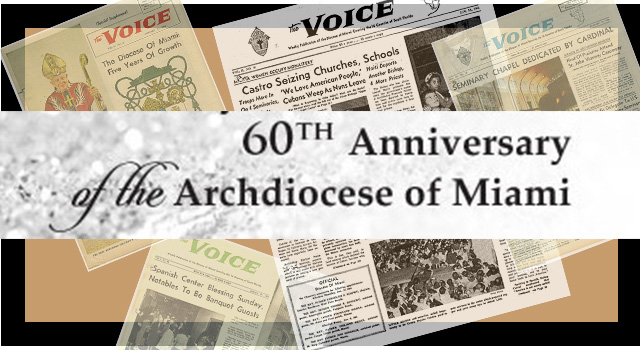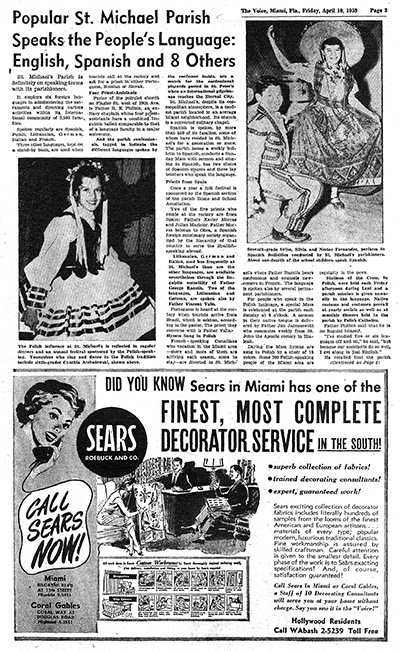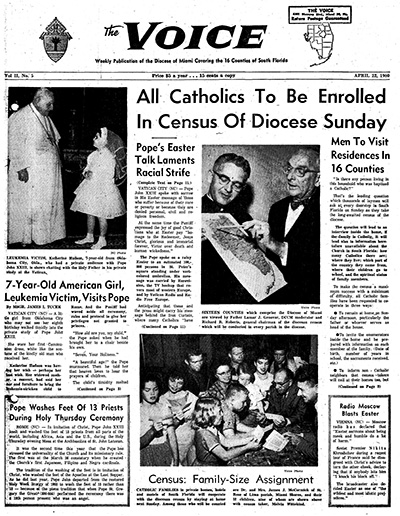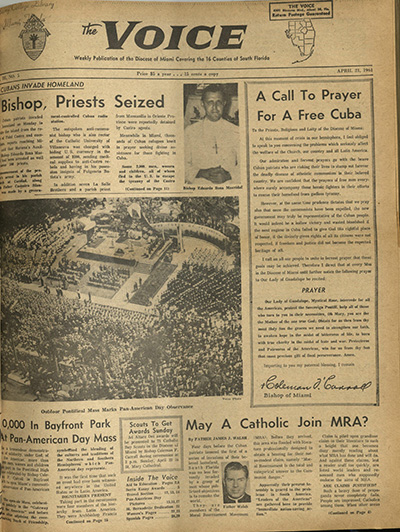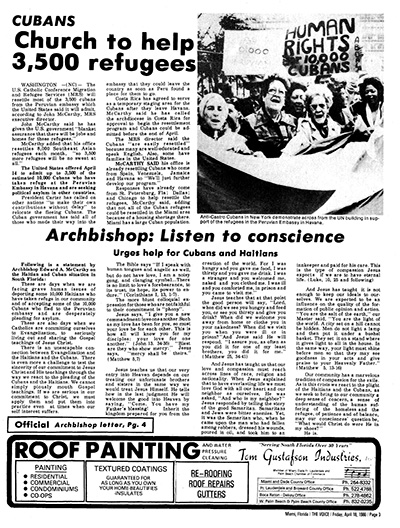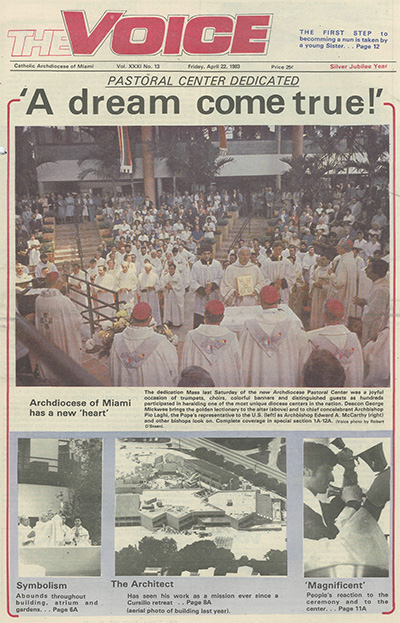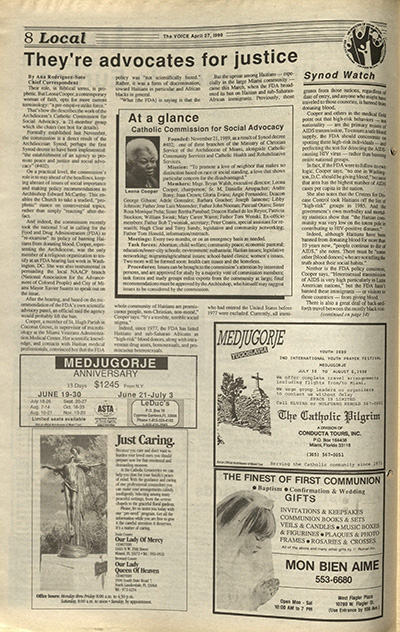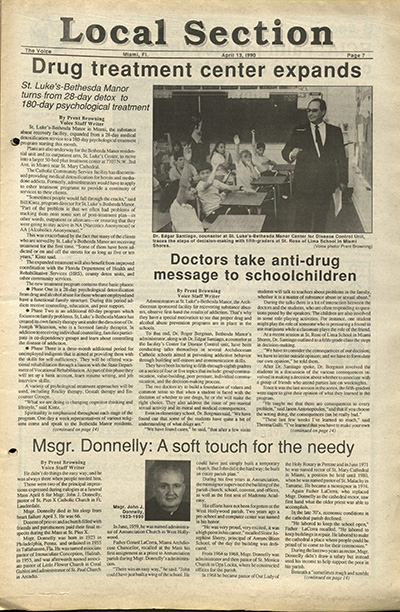By Florida Catholic staff - Florida Catholic
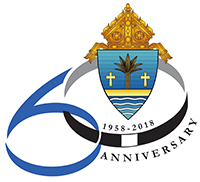
MIAMI | Editor’s note: The following is a new feature highlighting a month in archdiocesan history, as the Miami archdiocese continues its 60th anniversary celebration. A “White Gala to Honor the White Collar” will take place Oct. 20, 2018, with proceeds benefiting the two local seminaries. Here are some of the historical highlights for April. Click on the images to see a digital copy of the newspaper.
1959
• An article in The Voice, the diocesan newspaper, notes that St. Michael Parish in Miami “Speaks the People’s language: English, Spanish and 8 Others.” The languages spoken when administering the sacraments, and during activities with the 2,500-family community, include Polish, Lithuanian, German, Italian and French. Three others — Portuguese, Russian and Slovak — are available on “standby,” for when tourists call at the rectory and ask for a priest.
1960
• What was then known as the Family Life Bureau begins offering a series of seven lectures aimed at newlyweds or couples planning marriage in the next few months. The lectures cover “the spiritual, psychological and physical aspects” of marriage and family life. “a certificate will be awarded to those attending the entire series. This certificate is expected of all couples registering for marriage in their parish.”
• The diocese sends out “thousands of laymen” to “every doorstep in South Florida” on Sunday, April 24, in order to conduct a census of all Catholics in the diocese. They will ask: “Is there any person living in this household who was baptized a Catholic?” The goal is to obtain information until now unavailable: how many Catholics there are in South Florida; where they live; which part of the country they come from; where their children go to school; and the “spiritual status of family members.”
1961
• The Bay of Pigs invasion takes place in Cuba and reports reach Miami that more than 100 priests, including Havana Auxiliary Bishop Eduardo Boza Masvidal, have been arrested. Bishop Coleman Carroll calls on Catholics to pray for a free Cuba by reciting a prayer to Our Lady of Guadalupe “at every Mass … until further notice.”
1980
• In response to the planned deportation of 10,000 Haitians from South Florida, as well as the situation of 10,000 Cubans who sought refuge in the Peruvian embassy in Havana (giving rise a few weeks later to the Mariel boatlift), Archbishop Edward McCarthy issues a statement which includes this observation: “There is an unescapable connection between evangelization and the Haitians and the Cubans. There is even more a challenge to test the sincerity of our commitment to Jesus Christ and his teachings through the way we react to the pleading of the Cubans and the Haitians. We cannot simply piously mouth Gospel teachings. If we are serious in our commitment to Christ, we must apply them and put them into practice even at times when our self-interest suffers."
1982
• A boatload of Haitians seeking freedom in the U.S. drowns off Boca Raton; 21 of them are buried at Our Lady Queen of Heaven Cemetery, North Lauderdale, following Mass at St. Clement Church, Fort Lauderdale.
1983
• The archdiocesan Pastoral Center is dedicated April 16 by Archbishop Pio Laghi, Apostolic Delegate in the U.S. Concelebrating the Mass with him is Archbishop McCarthy, who envisioned bringing all archdiocesan offices together in one building and contributed to its design.
1989
• Divine Mercy Haitian Catholic Mission opens at 1120 Powerline Road, Fort Lauderdale, the first permanent home for Broward's Haitian ministry. In addition to offering a full Sunday schedule of Creole Masses, the mission will help Haitians find jobs and access social services.
1990
• St. Luke’s-Bethesda Manor switches from a 28-day medical detoxification facility to a 180-day psychological treatment program for addicts. Future plans include moving to a new, 50-bed building near St. Mary's Cathedral. Operated by Catholic Charities, Bethesda started as a home for alcoholics in the mid-1960s, then became a detox facility where heroin addicts could obtain methadone to ease off the addiction. St. Luke’s is an outpatient counseling center.
• The newly-established Catholic Commission for Social Advocacy leads a successful campaign against a Food and Drug Administration policy banning Haitians and others from African nations from donating blood in order to prevent the spread of AIDS. After the largely Haitian student-body at Curley-Notre Dame High School boycotted a blood drive because of the policy, the commission persuaded the Mayor of Miami and the local branch of the NAACP to testify in Congress against the ban. The commission, using the government's own studies, proved that the policy was not scientifically based, and was, in fact, discriminatory.
1992
• To mark the 500th anniversary of the arrival of Christianity to the New World, the archdiocese's Offices of Evangelization and Lay Ministry begin training volunteers to go door to door visiting the homes of their neighbors. The goal is to invite the unchurched to the nearest Catholic parish. If necessary, they are to apologize for any snub or misunderstanding on the part of the Church that may have led them to separate themselves from the faith community.
• Keeping with the 500th anniversary theme of evangelization, Cuban Catholics in the archdiocese met to reflect on their history, their spirituality as a people, and their relationship with their suffering brothers and sisters on the island. CRECED, Spanish initials for Reflections of the Cuban Church Community in Exile, began with a survey of exiles all over the world, from which were culled themes for discussion and reflection.
1993
• At the Vatican-mandated retirement age of 75, Archbishop McCarthy, spiritual leader of South Florida's Catholics for almost 17 years, submits his resignation to Rome.
1997
• With its namesake on hand for the ceremony, Archbishop John C. Favalora breaks ground for Archbishop Edward McCarthy High School, the first Catholic high school to be built in Broward County in 36 years. The $12 million facility will enroll its first freshman class in August 1998.
1998
• Beginning during Holy Week and continuing through the end of May, the archdiocese airs a series of television commercials asking the unchurched and fallen-away Catholics, both in English and Spanish, to “Come home to the Church. Come home to your parish.” The cost of producing and airing the 30-second spots — at peak viewing times — was covered by a $200,000 gift from the Koenig family, owners of City Furniture.
1999
• Archbishop Favalora urges U.S. Attorney General Janet Reno to review the cases of legal immigrants who are being indefinitely detained and/or deported to their native countries because of run-ins with the law, regardless of whether they have served their time and been upstanding citizens ever since. Haitians who left their homeland as children are facing deportation to a country they do not know, while leaving wives and U.S. born children behind. Families of Cubans at the Krome Avenue camp have been on a hunger strike for four months to protest the indefinite detention of their relatives, who cannot be deported to Cuba but, according to INS, are not eligible for release. An estimated 4,000 people are being detained under these circumstances around the country. “In our view, INS can, under present authority, establish independent and impartial panels of citizens to review fairly the cases of detainees so that those who pose no threat to society can be released to their families,” the archbishop said in his statement.
